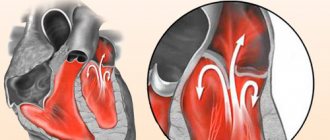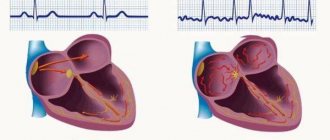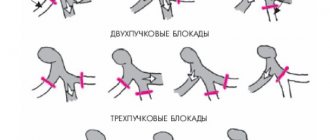Heart disease and the army
It is known that among 40.1% of conscripts, problems were found in the functioning of the cardiovascular system. Therefore, young men of military age are concerned with a lot of questions, including whether they will be accepted into the army with tachycardia. As they say, “you need to know the enemy by sight,” so it’s worth understanding what tachycardia is. This is a heart rhythm disorder in which the heart rate exceeds 90 beats per minute and sometimes even reaches 150 or higher. Normally, a person’s heart contracts rhythmically, heart rate is 70 and -/+10, i.e. from 60 to 80 beats per minute. With tachycardia, these indicators are sharply increased, the arteries in the neck may pulsate, and a feeling of anxiety appears.
The sinus node is considered to be our main “controller” of the heart. So, if problems arise in its automaticity, tachycardia or bradycardia appears. The second voiced rhythm disturbance is manifested by a decrease in heart rate. Here, doctors very often resort to implanting an artificial pacemaker, the presence of which is a priori considered a contraindication for military service. But our question remains open, whether people with tachycardia are recruited into the army or not.
Complete list of diseases that are exempt from the army
The full list contains hundreds of diseases and health conditions that limit a conscript's fitness for service or are completely exempt from conscription. The current list of such diseases for 2020 can be found on legal information portals. We recommend a copy of this list on the Consultant portal, since all regulatory documents are kept up to date there. All changes to laws that have come into force are instantly displayed on the portal.
The current list of diseases consists of 16 sections, of which conscripts are interested in 15. Health conditions related to pregnancy and childbirth are indicated for female military personnel.
How to correctly read the list of diseases in order to find those with which they will not be accepted into the army in 2020:
- Open the desired section (for example, the first one is “Infectious and parasitic diseases”).
- Find the desired disease in the list.
- Turn to the “I column” column and see which letter is indicated there.
This is what one of the schedule sections looks like
Letters from A to D for military registration and enlistment office employees indicate the degree of fitness for service:
- A – fit for military service;
- B – fit for military service with minor restrictions;
- B – limited fit for military service;
- G – temporarily unfit for military service;
- D – not fit for military service.
Accordingly, for complete exemption from military service, it is necessary that the letter D appears opposite the corresponding disease in the first column.
As for the second and third columns opposite the diagnosis, it makes sense to keep in mind the column “II column”. It also includes those who are already serving in conscription and who were diagnosed with one or another in the army. If this diagnosis, according to the list of illnesses, means that he is unfit for service, the serviceman must be discharged early.
If you find an error, please select a piece of text and press Ctrl+Enter.
Medical examination at the military registration and enlistment office and tachycardia: what to do?
You need to understand that physiological tachycardia is not dangerous and is considered normal. A pathological form of tachycardia occurs in 13.9% of young men drafted into the ranks of the Russian army. The decision on whether a young man will serve or not is made by the VC medical commission. But it is important to understand that such a disease carries a lot of dangers, which are due to the fact that the volume of ejected blood decreases. The heart simply does not have time to make a full ejection due to frequent and sometimes irregular contractions.
This can cause the walls of the heart to stretch and blood clots to form in the lower parts of the heart. Such disturbances in intracardiac dynamics are fraught with dangerous consequences that pose a threat to life. However, whether or not someone with tachycardia is accepted into the army becomes clear only in an individual, specific case, after weighing all the pros and cons (all the nuances are described in the Schedule of Diseases).
During a medical examination at the military registration and enlistment office, young people undergo electrocardiography, but a regular ECG and even with additional leads may not always be effective. The thing is that tachycardia, like bradycardia, can be episodic, transient. Therefore, it would be rational to conduct 24-hour monitoring or Holter ECG. This is a completely painless procedure when electrodes are attached to the patient, similar to traditional cardiography, but the cardiogram is “recorded” within 12 hours or days on a special device.
This small unit is carried with you in a purse on a strap; at this time it is forbidden to wet the body and equipment. And such a study does not have any special contraindications. After the monitoring time has expired, the Holter ECG data is transferred to a computer and the cardiogram is analyzed. Thus, the slightest, episodic or permanent violations will be recorded. The results of the study will help determine whether a particular person can serve in the army with tachycardia.
Top diseases with which young men are not called up for military service
Parents of conscripts, young people themselves, waiting for the next conscription campaign, are often looking for information that allows them to find out exactly what they are not taking into the army in 2020, how to use the opportunity to get a “military”, citing health reasons.
According to statistics, when recruiting the next batch of fighters, more than half of the guys have pathologies that do not allow them to fulfill their military duty on an equal basis with other fighters.
The approved list of certain pathologies that do not imply sending a recruit to the army is quite impressive; all of them are clearly stated in the “Schedule of Diseases.”
However, there is a list of the most common ailments that are most common among representatives of the younger generation of military age:
It is found in a huge number of young men, but only conscripts with 3rd or 4th degree can be released from the army due to flat feet.
- Hypertension (not to be confused with arterial hypertension).
Pressure surges can be dangerous to the health/life of a young man who is exposed to increased stress, without which everyday life in the army cannot go by.
- Visual impairment.
Pathologies associated with various dysfunctions of the visual organs are also diseases for which they are not accepted into the army, subject to confirmation of serious disorders: astigmatism, strabismus, poor vision with pronounced indicators. With minor deviations from the norm, the guy will be considered of limited fitness.
- Scoliosis.
To receive an exemption, at least second degree scoliosis must be established. A curvature of the spine will become an obstacle for a fighter.
The young man is not fit for service if he has the following skin diseases: urticaria, eczema, psoriasis, dermatitis, and other serious pathologies that can worsen in military conditions.
It is necessary to collect and provide supporting medical documents to prove the presence of the disease.
Expert opinion
Davydov Dmitry Stanislavovich
Deputy Head of the Military Commissariat
This list includes only a small part of the main diagnoses, which most often become a valid reason for declaring a conscript unfit for service.
The general list consists of a huge number of various pathologies, some of which are much less common, but also do not allow the young man to go off to fulfill his military duty along with the rest of the recruits.
"Pitfalls" during a medical examination
Sometimes a young man’s complaints can be ignored by members of the commission at the military registration and enlistment office, so it is advisable to undergo an examination of the whole body in advance at the district clinic. Both permanent and temporary health problems can be an obstacle to military service. In order to understand the problem, they may be given a deferment from service with a second medical examination. You can make the right choice only by taking into account all the information. This is why it is so important to seek medical help throughout your life, especially if you have heart problems. Then, at the medical examination at the Military Commissariat, you will know for sure whether it is possible to serve in the army with tachycardia (see categories of fitness for military service). Negligence and inattention of medical staff can cause serious violations in the future. After all, we know of cases when soldiers lost consciousness on an obstacle course and were sent straight from the exercise to the hospital. Why put your body in danger if you have heart disease.
If a person is diagnosed with sinus tachycardia without other disorders, he will still have to serve in the army. Of course, doctors can give a delay, followed by treatment, but a course of sedatives brings the heart “in order.” Tachycardia, which is combined with other serious heart disorders, can be exempt from military obligations. For any physical activity can aggravate the young man’s condition and cause irreparable harm to his health.
Here is a small list of heart pathologies for which military service can only be a dream:
- IHD
- Acute heart failure
- Cardiosclerosis
- Cardiac conduction disorder
- Heart defects
- Implantation of IVR
- MK prolapse
Causes of pathological tachycardia
The medical commission at the military registration and enlistment office assigns a fitness category to everyone, so in order to determine the pathology causing tachycardia, it is necessary to undergo a medical examination. Whether the young man will be called up to serve in the armed forces depends on the identified pathology and its degree. The most common diseases causing tachycardia:
- VSD (vegetative-vascular dystonia);
- IHD (coronary heart disease);
- infectious and ischemic lesions with poor functioning of the sinoarterial node;
- thyrotoxicosis;
- acute and chronic heart failure;
- fever and cardiac conduction disturbances;
- various anemias and oxygen starvation;
- hypovolemia;
- cardiosclerosis;
- mitral valve prolapse;
- myocarditis.
If the disease causing tachycardia is accompanied by disturbances in heart rhythm and cardiac function, then the young man most likely will not have to serve. Provided that the conscript regularly visits a cardiologist, his complaints are recorded in medical documents and the diagnosis will be confirmed during further examination according to an act from the military registration and enlistment office. In other situations, military service with tachycardia is possible, but troops with special conditions of service (with less physical activity) will be selected.
Why don't they take you into the army?
Do you dream of an army? Want to serve in an elite unit like Special Forces, but have trouble seeing the top line on the chart? Then you can forget about your brilliant military career.
This article will help you figure out which diseases are not accepted into the army, and what will not be an obstacle on your way.
Five categories of suitability for military service
In order to understand whether you are fit for military service, you need to figure out what this is - a “fitness category”, and what is hidden behind the letters A, B, C, D and D, which you encounter at every step when reading the Schedule of Diseases .
There are five categories of suitability of young people for military service:
- A – fit;
- B – in general, the guy meets the requirements, but there are minor limitations;
- B – limited suitability, or “with conditions”;
- D – temporary non-compliance with the conditions of the medical examination, the young man is given a deferment to get his health in order;
- D – not suitable.
Spinal diseases
Shortly before graduation, many guys, especially those who spent all their years of study at the computer, begin to be interested in the question: do people with scoliosis join the army? And if for the last couple of years they have not been able to turn their heads without a crunch in the cervical vertebrae, they are even more likely to register themselves as disabled.
If a conscript has scoliosis of the first degree, in which abnormalities in posture are almost imperceptible, then without an extract from the medical card, which records the diagnosis and medical history, and the accompanying image of the spine, the commission will almost certainly decide that the guy is fit for military service. True, the road to special forces, along with other elite units, will be closed to him.
The presence of second degree scoliosis exempts you from military service, but only if complaints of back pain were recorded in your medical record. If in the last year or two you have often (at least once every two months) gone to the clinic with complaints of pain and stiffness in the spine, a feeling of numbness in the legs or muscle weakness, you will most likely have to forget about the army.
If a guy has grade III scoliosis, in which the curvature of the spine is visible to the naked eye, he is exempt from military service, as with the even rarer grade IV scoliosis - in other words, a hump.
You can read more about this in article 66 of the Disease Schedule.
What if a conscript has osteochondrosis?
A spinal deformity that is clearly visible on an X-ray, an intervertebral hernia, or attacks of acute pain that appear as soon as you vacuum the floor - all of these are serious deviations that make military service in peacetime unavailable to you.
Cervical osteochondrosis, which few people take seriously, is one of the diseases that is absolutely incompatible with military service. And it’s not even about him himself, but about the complications that may arise.
The presence of multiple growths that appear in the area of the intervertebral joints threatens radiculopathy, intervertebral hernia, and loss of mobility - partial or complete. And if compression of the spinal cord occurs, the consequences can be the most terrible: legs will fail, paralysis will occur, or even death.
If you have intervertebral osteochondrosis, you will most likely not get emergency service. With this diagnosis, they are most often written off to the reserve.
Problems with the lower back, unless they are accompanied by severe pain, will not be a limitation for military service. Just in case, bring an x-ray to the commission: if it shows that three or more vertebrae are affected by the disease, and it is clearly visible that they are deformed, you will be released from service.
Therefore, if you feel back pain, make an appointment with your doctor immediately. You won’t end up in the army anyway, but at least you can preserve what’s left of your health.
Flat feet
Probably everyone has heard that people with flat feet are not accepted into the army, but not everyone knows how things really are. People who do not have this disease can be counted on one hand. Therefore, they take whoever is there, but not everyone.
Probably everyone has at one time or another been tested for flat feet: they smeared the sole with a thick cream, and then put it on a sheet of paper and looked at the resulting imprint. If a deep groove was noticeable on the inside or nothing was imprinted between the heel and metatarsus, this meant that you did not have flat feet. If the entire foot was visible, the school nurse wrote a referral to a podiatrist.
With III or IV degree flat feet, when almost the entire foot is in contact with the horizontal surface, military service is incompatible. You fall under category B, meaning “limited fit.”
It’s another matter if the conscript has I or II degree flat feet. With I degree there are no restrictions, a young man can serve in any branch of the military, and with II degree service cannot be avoided.
Illnesses due to which a deferment or exemption from service is given
There are many diseases that do not allow you to serve in the army.
Expert opinion
Davydov Dmitry Stanislavovich
Deputy Head of the Military Commissariat
There are not many people who are released from the army due to various diseases. It all depends on the degree and form of the disease. The most common reasons why a person is exempt from military service:
- Scoliosis of the second degree. At this stage, curvature of the shape of the spine occurs. The degree of curvature is at least eleven degrees. At the same time, there should be no sensitivity or reflexes in the tendons.
- Flat feet, third degree. This disease is popularly called “bear foot”. With this disease, it becomes almost impossible to move around in army shoes, since they have a standard pattern.
- Joint disease. This means grade 2-3 arthrosis, which affects the joints of both legs.
- Blindness or vision problems. Those people who have been found to be completely or partially blind (in one eye) are not accepted into the army. In addition, conscripts who suffer from myopia and have a detached retina or glaucoma are not included in the army. People who have experienced significant visual trauma are also not suitable.
- Hypertension. If the examination reveals a blood pressure of 150 over 95 when the person is at rest, this means that the blood pressure is elevated and he is not allowed to serve.
- Disorders of the auditory organs. If, during an examination at the military registration and enlistment office, it was discovered that the conscript did not hear what was said in a whisper at a distance of more than two meters, this will indicate poor hearing. Unfit are deaf (in one ear or both) people, as well as those with chronic otitis media, which has a negative effect on breathing through the nose. Deaf and mute people also do not serve.
- Stomach disorders and duodenal problems. Because of ulcers, a person will not be accepted into the army.
- Chronic pancreatitis.
- Hernias that lead to disruption of the normal functioning of the digestive system.
This is important to know: What to do if you have lost your summons to the military registration and enlistment office
What else can interfere with military service?
- Missing one or more fingers; deformed limb.
- Having a limb amputated or lost in other circumstances also prevents recruitment into the armed forces. It is worth noting that a fracture provides only a temporary reprieve, after which the conscript undergoes a re-examination and if no critical consequences of the fracture are found, then he is accepted for service.
- If the x-ray shows bone deformation, which is caused by old injuries or dislocations, recruitment will not be made. If stones (at least 5 mm in size) are found in one of the organs, the person will be sent for treatment, and his ability to join the army will be in question.
- Mental health problems such as schizophrenia, multiple personality disorder, or the presence of paranoid fears and other disorders will prevent a person from serving. At the same time, the authenticity of the presence of mental illness is carefully checked due to the fact that many people want to “dismiss” in this way. The presence of a certificate confirming the illness is checked and the supervising doctor must be indicated. The period of time from which the detected deviations have been observed is also indicated.
- Speech defects that make it impossible to understand what a person is saying. An example is stuttering in a severe form.
- Diabetes mellitus or obesity in the third stage are exempt from service.
- Vegetative-vascular dystonia, due to which a man suffers from frequent and severe dizziness, accompanied by loss of consciousness. But such a problem must be confirmed by a certificate from a medical institution.
- Hemorrhoids in the second degree become an obstacle to recruitment.
- People with urinary incontinence do not join the army.
- Present disorders of the respiratory system in the form of asthma, tuberculosis of any form and other diseases of the first degree that affect the functioning of the lungs and respiratory tract.
- Heart problems: defects, irregular rhythm, arrhythmia. A conscript with such disorders is not allowed to serve.
- A deferment is provided to men who have testicular hydrocele or hyperplasia.
In addition, patients diagnosed with AIDS, hepatitis C and similar diseases are not accepted for service. I wonder why? Because in the army there is regular contact with each other and people who have such serious illnesses cannot be accepted for service.
Also, people who have been diagnosed with alcoholism or drug addiction are not accepted for service. There must be confirmation that the person is registered with a drug dispensary.
What diseases are not accepted into the army 2019
Teachers have this opportunity - for spring conscription from May 1 to July 15. In 2020, a potential conscript can join the following branches of the military:
- ground troops;
- Navy;
- space forces;
- strategic missile forces;
- air Force;
- airborne troops.
The specialty that the conscript possessed and his state of health are important. Traditionally, only the strongest and most physically resilient young people with a strong psyche and good health are accepted into the Airborne Forces.
A citizen will not be required to join the army in 2019 if he:
- works in the Federal Security Service;
- belongs to the Ministry of Emergency Situations workers.
- has a permanent job in the structures of the Ministry of Internal Affairs;
Contraindications for military service
Arrhythmia itself extremely rarely leads to exemption from military service. An important factor in this case is the presence of concomitant diseases; the type of sinus arrhythmia and the possibility of serious complications are no less important.
Dangerous types of arrhythmia are considered:
- ventricular extrasystole;
- primary prolapse;
- paroxysmal tachycardia;
- weakening of the sinus node.
These types of diseases are a contraindication to military service. It is difficult for a person with this diagnosis to engage in self-care. Often diseases of this group appear under the influence of myocarditis, heart attack, and cardiosclerosis.
The presence of a diagnosis of AV block of the first and second degree, complete blockade is the reason for exemption from the army. An obstacle to completing the service may be incomplete blockade of the right bundle branch.
If a young man is diagnosed with dangerous diseases that cause the development of sinus arrhythmia, the conscript will be released from the obligation to serve in the army and will be excluded from the list of those liable for military service.
The presence of a rheumatoid type of disease, as well as heart failure, is a contraindication for military service. The medical commission carries out a comprehensive diagnosis for the presence of concomitant ailments, the leading opinion is the testimony of the cardiologist.
DETAILS: ATP for hypertension
In case of persistent arrhythmia, the young person is assigned category B. Persistent arrhythmia is characterized by prolonged attacks that last longer than 7 days. This condition requires drug therapy, and if it is stopped, the disease returns again.
Military conscription 2020 - restrictions and details. Schedule of illnesses.
Traditionally, only the strongest and most physically resilient young people with a strong psyche and good health are accepted into the Airborne Forces. A citizen will not be required to join the army in 2019 if he:
- works in the Federal Security Service;
- belongs to the Ministry of Emergency Situations workers.
- has a permanent job in the structures of the Ministry of Internal Affairs;
There is the most important limitation - if a citizen nevertheless decides to resign from there, but at that moment he is under 27, then he will definitely receive a mandatory summons from the military registration and enlistment office!
The following will be avoided from conscription into active military service:
- Citizens under investigation for a crime or on trial will avoid conscription;
- serving their sentence in a penitentiary institution.
- adult men with one or more convictions that have not been expunged for many years;
Heart disease and the army. Heart failure
In addition, the presence or absence of normal blood flow will be taken into account when examining other diseases of the heart, blood vessels, internal organs and body systems, and then a decision will be made whether they will be drafted into the army with heart failure. For example, with significant damage to the heart, changes occur in the liver, kidneys, and lungs.
Symptoms of chronic venous stasis include:
- cardiac cirrhosis of the liver with possible development of liver failure.
- thrombosis and embolism;
- rhythm and conduction disturbances;
- a blood clotting disorder, in which blood clots form in small vessels;
- disturbances of electrolyte metabolism and acid-base status;
Roughly speaking, to the extent that the disease reduces the normal functioning of the heart, the conscript will be considered unfit for military service.
For what diseases are they given a deferment from the army?
For some diagnoses and injuries, you cannot be exempt from military service, but you can get a deferment for several months, six months or even a year. Typically, this situation is typical for injuries or diseases that can be cured: broken arms or legs, nail and skin fungus, lack of weight, obesity, lichen, sexually transmitted infections, etc.
The military registration and enlistment office can also grant a deferment for those pathologies that require enrollment in the reserves (even for those for which a deferment is not provided for by law). In these cases, conscripts are temporarily released from conscription in order to perform an operation or observe the diagnosis, check its dynamics and the frequency of relapses.
Most often, such a deferment is given for the following health problems:
- asthma,
- varicose veins and varicocele,
- haemorrhoids,
- hypertonic disease,
- underweight,
- thyroiditis,
- obesity,
- exacerbation of ulcers,
- skin diseases (psoriasis, eczema, dermatitis or urticaria),
- urolithiasis disease.
With respect to you, Artem Tsuprekov, head of the human rights department of the Assistance Service for Conscripts in St. Petersburg.
We help conscripts obtain a military ID legally.
What weight is not accepted into the army 2019 table
Also, young people with astigmatism are considered unsuitable for military service if the difference in refraction is more than 6 diopters. Myopia or farsightedness of more than 8 and up to 12 diopters, as well as astigmatism with a refractive difference of more than 4 and up to 6 diopters determine category B (limitedly suitable) for citizens of the 1st and 2nd groups and category B - suitable with minor restrictions (B - individually) - for the 3rd group of military personnel.
Visual acuity will be critical in the individual assessment of fitness for duty.
Advice for conscripts
Often guys who are determined to get an o or category “B” end up serving with the letter “B” in the military service, which implies only some restrictions when choosing a branch of the military.
The presence of a disease does not always become an argument for leaving the reserve.
Careful preparation before a visit to the military commissariat will help to avoid possible misunderstandings. A young person should stock up in advance on a package of documentation confirming the diagnosis.
It is better to spend time collecting the necessary medical certificates and extracts, and undergo an independent examination in advance, than to later appeal the decision made by the commission in various instances.
Sometimes employees working in military registration and enlistment offices commit outright violations, ignoring approved diagnoses. The desire to replenish the troops with the next batch of recruits often leads to incorrect assignment of category, and the newly minted soldier, despite health problems, is sent to the army for 12 months.
Not all conscripts are ready to defend their rights on their own, so it is worth enlisting the support of specialists in advance.
Can they join the army with tachycardia: service or deferment?
We need more compelling reasons.
- Supraventricular paroxysmal (supraventricular).
It occurs in the form of an attack in which the heart rate jumps sharply to 250 beats/min. Requires immediate medical intervention, and if attacks recur, therapy.
A conscript can count on category “G” – temporarily unfit – for the period of treatment. Ventricular is a dangerous form of pathology that poses a threat to life.
The draft commission takes into account the opinions of various doctors, recognizing the young man as fit for military service.
Fit categories with arrhythmia
Arrhythmia becomes a reason for deferment or enlistment if it is a symptom of a serious illness. Depending on the severity of the pathology, the IVC assigns the young man one of the existing categories:
- A – absolutely healthy, fit for service in any of the units;
- B – there are some validity restrictions;
- B – may be called up in wartime;
- D – temporary suspension from conscription, usually given for six months;
- D – a person cannot be taken into the army under any circumstances.
Young people with arrhythmia are most often assigned category B. Next to the letter designation there is a number from 1 to 4, indicating the troops to which the conscript can be sent.
Boys with minor abnormalities in the functioning of the heart receive category B-3. This group includes all diseases that do not have a significant effect on the functionality of the body. Men with category B-3 can be recruited into the army in peacetime and wartime.
Schedule of illnesses in 2020 from military conscription
That is, to find any ailment in it, you should start with the most general diagnosis. Every disease affects one of the body systems.
The categories are encrypted according to them in the schedule. In total it includes 16 groups. The reading sequence is as follows:
- Open it and select the disease prescribed in the diagnosis.
- We see a table in which the cause of the disease and the corresponding categories are described in detail.
- We look at our medical card and choose which system is affected (eyes, bones, etc.).
- We are looking for the corresponding section in the schedule.
- Open the item corresponding to the disease.
Important: the table has three columns with alphabetic codes.
They should be understood as follows:
- For citizens enrolled in the reserve.
- For conscripts.
- For contract workers.
Let’s say a young man’s retina is damaged.
Schedule of illnesses
The list of illnesses is an official document that is included in the “Regulations on Military Medical Examination” and contains a list of diseases that allow or do not allow a conscript to serve in the army.
The disease schedule contains 88 entries and covers about 2,000 different diseases.
According to statistics, about 97% of conscripts in the Russian Federation are unfit for service due to health reasons
To better understand how to behave at the military registration and enlistment office with any disease, watch our video
Below you can see the sickness schedule and find out if you are fit for military service. Our medical law specialists are always ready to advise you if it is difficult for you to understand on your own the meaning of the articles and comments to them.
Take a virtual commission at a makeshift military registration and enlistment office and find out your chances of not joining the army
Infectious and parasitic diseases
Neoplasms
Diseases of the blood, hematopoietic organs and certain disorders involving the immune mechanism
Endocrine system diseases, nutritional disorders and metabolic disorders
Mental disorders
Nervous system diseases
Diseases of the eye and adnexa
Diseases of the ear and mastoid process
Diseases of the circulatory system
Respiratory diseases
Digestive diseases
Diseases of the skin and subcutaneous tissue
Diseases of the musculoskeletal system and connective tissue
Diseases of the genitourinary system
Congenital anomalies, deformities and chromosomal disorders
Consequences of injuries, poisoning and other influences of external factors
Other diseases
Body mass index, height ratio, weight ratio, height-to-weight ratio
Statistics show that about 97% of young men of military age are medically unfit to serve in the armed forces. All diseases that are not accepted into the army are collected in a regulatory act developed by specialists. This is what guides members of military registration and enlistment commissions throughout the country.







